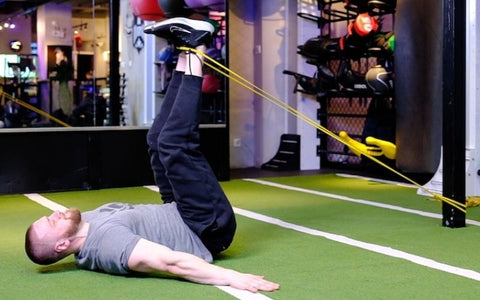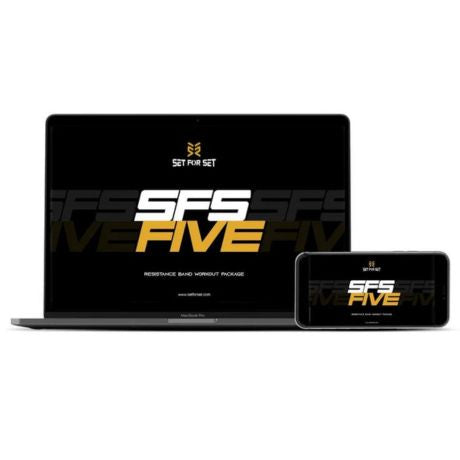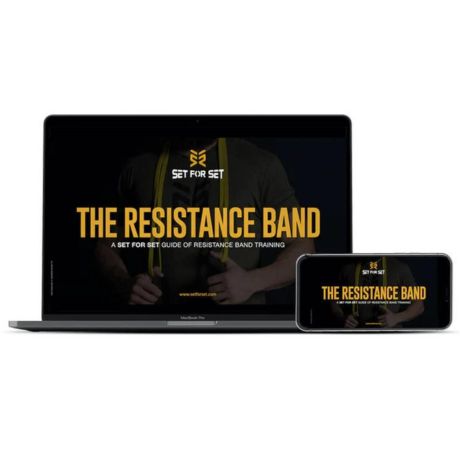Want your perfect workout program?
Take Quiz5 Resistance Band Core & Ab Exercises for a Killer Core Workout

Written by Sam Coleman | Co-founder
Fact checked by Kirsten Yovino, CPT Brookbush Institute
 FACT CHECKED
FACT CHECKED
If you want to turn the intensity of your core workouts up to eleven, you need to implement resistance band core and ab exercises. Bands don’t just add resistance to your core exercises, they also give you more exercise options and allow you to properly target your core through all three planes of motion. This is what to takes to develop a truly powerful, strong, injury resilient core...and, of course, the added benefit is a six pack with shredded obliques.
5 RESISTANCE BAND CORE & AB EXERCISES
- Heel Touches
- Ab Twists
- Side Bends
- Woodchopper
- Leg Raises
1. Heel Touches

The resistance band heel touch is a type of crunch, so it mainly ab focused.
You wrap the band around your upper back and hold each end with your hands. By doing this, you are adding resistance to the crunch. The full range of motion brings your shoulder blades from touching the ground to up off the ground with your hands by your heels. You will feel a very strong contraction in your abdominals.
Plane of motion: Sagittal
Primary muscles worked: Rectus abdominis (particularly your upper abs)
Ideal rep range: 10-15 reps
Related: Alternating Heel Touches Form Guide for Beginners
2. Ab Twists

The resistance band ab twist is the perfect example of a transverse plane rotational exercise. With free weights, this movement would not work the same because the resistance would be downward, making it more of an arm workout. Whereas with the band, the elastic tension is created horizontally, allowing you to truly create resistance through the transverse plane.
Note: This can also be done with a cable pulley machine to the same effect.
We really love this resistance band core exercise because it hits pretty much the entire core and it hits those deep core muscles, especially if you focus on maximum tension.
To do this exercise, anchor the band at sternum level. Step a few feet directly to side, so that the band is taut and your hips and body are perpendicular with the anchor point. Keep your arms extended at all times. Rotate towards the anchor slowly, when your arms are aligned with the anchor, rotate the opposite way 180˚. Your hips will be rotating as you twist back and forth. Keep your core tight throughout the movement.
Feel free to be explosive as you rotate away from the anchor (but always slow as you rotate back towards the anchor) once you get comfortable with this movement and your core strength improves.
Plane of motion: Transverse
Primary muscles worked: Rectus abdominis, transversus abdominis, external obliques, internal obliques, multifidus, quadratus lumborum, multifidus, erector spinae
Ideal rep range: 10-12 reps (each side)
3. Side Bends

You may have seen this exercise being down with a cable pulley machine. With a resistance band, you can do the side bend anywhere that you can anchor the band directly above you (i.e. a pull up bar).
The resistance band side bend is an oblique focused exercise, but it will also work your low back well.
Anchor the band directly above you and move your body just to the side of the band so it is shooting straight down in line with your working side’s shoulder. Bend to the side, leading the movement with your elbow. Your elbow should come down and touch your hip. Think of it like you are doing a side crunch. Hold the position for a second or two, then slowly come back up. Really focus on maximum contraction and move slowly. This is not an explosive exercise.
Plane of motion: Frontal
Primary muscles worked: External obliques, internal obliques, quadratus lumborum, and erector spinae
Ideal rep range: 10-12 reps (each side)
4. Woodchopper

You’ll see people doing this exercise with dumbbells, and while it does work the transverse plane, it’s not as effective as it is with bands. This is because the tension is perfectly targeted in the direction of the movement (diagonal), whereas with dumbbells, most of the tension is focused on keeping the arms in position. You can still create force in a diagonal, spiral pattern, but the actual resistance is in a downward direction due to gravity. So, this exercise should be done with a resistance band for the best results.
To do this exercise, anchor the band to a low point (about ankle/feet level). Step away from the anchor until the band is taut. Your arms will be extended at the elbow at all times, so keep them straight and locked out. Bring your arms down to the side, in the direction of the band’s anchor, with your hips and trunk rotated towards the same direction. This is the starting position. With your arms straight, bring the band up diagonally to the contralateral side. You will be rotating at both your trunk and hips. At the highest point, your arms will be higher than your head and your arms will be perfectly aligned with the band. Slowly return back down to the starting position in the same path of motion.
With this exercise, you can be explosive on the way up, but be slow on the descent.
Be sure to target both ways, meaning turn your body around to work the opposite direction. Also, you can anchor the band at a high point above your head to do high to low woodchoppers.
This exercise is great for the oblique slings. The oblique slings are like an X across your trunk, so by doing both sides and both high to low and low to high, you work your oblique slings in all directions.
Plane of motion: Transverse
Primary muscles worked: This is an oblique sling focused exercise that works your external obliques, internal obliques, rectus abdominis, transversus abdominis, multifidus, quadratus lumborum, multifidus, erector spinae, as well as your shoudlers, upper back, and glutes
Ideal rep range: 10-12 reps (each side)
5. Leg Raises

This exercise is very straight forward. It’s a lying leg raise with a band looped around your feet for added resistance.
Try to keep your legs as straight as possible when doing this exercise and the full range brings them from a few inches above to the ground to about perpendicular with your stomach.
Plane of motion: Sagittal
Primary muscles worked: Rectus abdominis (particularly your lower abs) and your hip flexors
Ideal rep range: 10-12 reps (each side)
RESISTANCE BAND CORE & AB WORKOUT
Use these 5 banded core exercises to make a killer multiplanar core workout.
- Heel Touches: 3 sets x 12 reps
- Side Bend: 3 sets x 10 reps each side (hold the contraction for a second or two each rep)
- Ab Twists: 3 sets x 10 reps
- Leg Raises: 3 sets x 10 reps
- Woodchoppers (low to high): 3 sets x 10 reps each side
- Woodchoppers (high to low): 3 sets x 10 reps each side
There’s no need to do countless reps. With the added resistance, you can treat your core like you would any other muscle, keeping reps within the 5-20 rep range each set.
For total body workouts check out our SFS Five Resistance Band Program.

The SFS FIVE Resistance Band Workout Package has 5 fun and challenging full length workouts using only resistance bands. Each workout targets different muscle groups. Together, the 5 workouts make for the perfect weekly workout routine.
CORE ANATOMY
Your core muscles include the rectus abdominis, transversus abdominis, external obliques, internal obliques, multifidus, quadratus lumborum, multifidus, and erector spinae.

Together, these muscles surround the front, sides and back of your mid and lower trunk.

Each of these sets of core muscles are as important as the next. They protect your spine and give you strength and balance when bending, leaning or twisting. In fact, they provide stability for every single movement you make. Moreover, they help transfer force between extremities - the stronger your core is, the more powerfully you can move.
Note: Your hip flexors and glutes also play a very important role in stability, and they are often considered part of the "core".
To have a strong core, you must train your core in its entirety. This means targeting all the various muscles with a variety of exercises that move you through all three planes of motion - sagittal, frontal, and transverse.

TRAINING YOUR CORE THROUGH ALL PLANES OF MOTION
First, let’s go over what kind of movements are sagittal, frontal and transverse.
Sagittal: The sagittal plane involves forward and backward movements, both with your body positioned vertically and horizontally...i.e. crunches, leg raises and planks.
Frontal: The frontal plane involves side to side movements...i.e. side planks, side bends, side planks with pulse.
Transverse: The transverse plane involves twisting/rotational movements...i.e. Pallof press, woodchoppers, Russian twists.
Exercises that resist movement also fall into these categories.
For example...
The side plank is anti-frontal, which is considered a frontal plane movement; The Pallof press is anti-rotation, which is a transverse plane movement.
What’s more, some exercises can fall into multiple categories. These are multiplanar exercises. For example, a Russian twist will work both the sagittal and transverse plane.
All in all, it’s important to build core strength through all three planes of motion, targeting your entire core from all angles. By strengthening your core in its entirety, you will have the strength, power, and injury resilience needed to combat whatever life throw at you.
Each plane of motion is important, but we’d go as far as to say the transverse plane is the most important. It is also the most overlooked. Transverse plane core work is the stuff that makes you hard to kill. So, don’t neglect it like so many trainees do!

WHY YOU SHOULD USE RESISTANCE BANDS FOR CORE AND AB EXERCISES
Bodyweight exercises alone can train your core pretty effectively. However, resistance bands are a great way to turn up the intensity. Moreover, with bands, you open yourself up to more options for core exercises, it is easier to target certain core muscles and planes of motion, and you can stress your muscles differently.
With just your bodyweight, you are somewhat limited. If you think about it, the resistance during bodyweight core exercises is created by gravity, and gravity works in one direction, down. Thus, you have to position your body in a very specific way to target specific muscles. Even if you add free weights into the mix, like dumbbells or a medicine ball, it’s still all about gravity.
With resistance bands, you can create resistance from any angle simply by where you anchor the band. This gives you a lot more training variables to play around with.
When it comes to the transverse plane, this is particularly important. With bands, you can work the transverse plane properly as you can anchor the band to your side to create resistance and tension through a spiral/twisting pattern. It’s a lot harder to train the transverse plane effectively with just your bodyweight alone or with free weights.
All in all, bands are great for core workouts because you can increase resistance, you have more options for exercises in each plane of motion, and you can really hone in on certain muscles. There are so many ways to use resistance bands to intensify your core and ab workouts. Pretty much any bodyweight core exercise can be modified using bands, adding resistance and making the movement more difficult (thus increasing your core strength, power, and injury resilience), and you’ll have all the exercise options that apply specifically to bands thanks to elastic tension.
Getting yourself a set of bands for core workouts is no brainer. After you see our 5 resistance band core exercises, we are sure you’ll agree. And remember, these are just 5 of sooo many.
To see what else resistance bands can do for you, check out our SFS Resistance Band Guide.

Our guide has over 250 exercises categorized by mobility, mobilization, resistance training, barbell training, explosive training, static stretching, and (p)rehabilitation...
Can resistance bands build abs?
With resistance bands, you will make your abs stronger and more defined. The added resistance will help promote muscular hypertrophy of your abs if you train hard and eat right. Moreover, the increased resistance makes it more difficulty, which means more calories burned, so even if they don’t grow, they will become more defined as you lose belly fat. Resistance bands are also great for making core moves, like the dead bug exercise, more challenging as your fitness level increases.
Do resistance bands burn belly fat?
You can't spot reduce fat, so you will lose fat evenly around your body. However, the good thing is, with bands, core exercise become more challenging, which gets your heart rate firing up at a much greater degree. Higher heart rate means more calories burned, which is what fat loss is all about. If you keep at it, your belly fat will melt away.
BUY A SET OF BANDS
If you want to take your core workouts to the next level, definitely get yourself of bands.
You’ll also be pleased to know that there’s so much more that you can do with bands. From warm up to workout to cool down, a set of bands will get a ton of good use.

More Resistance Band Targeted Exercises:

Also in Blog
Recent Articles
-
Calories In, Calories Out Myth: Fact or Fiction?April 08, 2025
-
Cardio Or Strength Training: What's Better For Weight Loss?April 03, 2025
Must Reads
-
Mr Olympia 2024: What to Expect This Year (Oct. 10-13, 2024)September 11, 2024
-
What Can Walking For 1 Hour Everyday Do For You? My ExperienceFebruary 28, 2024
-
The Ultimate "Bro Split" Workout Plan (Backed By Science)August 05, 2023
- Blog
- Exercises
- Workouts
- Meal Plans
- SFS Programs
- Apparel
- About Us
- FAQ
- Shipping
- Warranty
- Contact Us
- Terms & Conditions
- Privacy Policy
- Affiliates
- SFS UGC Policy
- SFS MBG Policy
- Disclosures
- Legal Disclaimer
Sign up to get the latest on sales, new releases and more…
© 2025
SET FOR SET.
Powered by Shopify
















Sam Coleman
Author